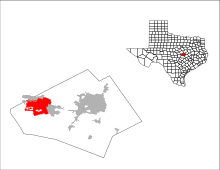
The École Polytechnique massacre, also known as the Montreal massacre, was an antifeminist mass shooting that occurred on December 6, 1989 at the École Polytechnique de Montréal in Montreal, Quebec. Fourteen women were murdered; another ten women and four men were injured.
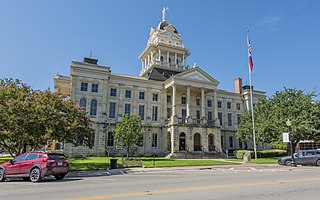
Bell County is a county in the U.S. state of Texas. It is in Central Texas and its county seat is Belton.

Killeen is a city in the U.S. state of Texas, located in Bell County. According to the 2020 census, its population was 153,095, making it the 19th-most populous city in Texas and the largest of the three principal cities of Bell County. It is the principal city of the Killeen–Temple–Fort Cavazos Metropolitan Statistical Area. Killeen is 55 miles (89 km) north of Austin, 125 miles (201 km) southwest of Dallas, and 125 miles (201 km) northeast of San Antonio.
The San Ysidro McDonald's massacre was an act of mass murder which occurred at a McDonald's restaurant in the San Ysidro neighborhood of San Diego, California, on July 18, 1984. The perpetrator, 41-year-old James Huberty, fatally shot 21 people and wounded 19 others before being killed by a police sniper approximately 77 minutes after he had first opened fire.

The Strathfield massacre was a shooting rampage at a shopping centre in Strathfield, Sydney, Australia, on 17 August 1991. The shooter was Wade Frankum, who killed himself as police arrived at the scene. The incident left eight dead and six wounded.

James Edward "Pop" Pough was an American spree killer who killed thirteen people in two separate attacks in Jacksonville, Florida on 17 and 18 June 1990. Pough shot and killed two people at random on Jacksonville's Northside, wounded two teenagers, and robbed a convenience store. Pough shot and killed nine people and wounded four others at a General Motors Acceptance Corporation car loan office the next day before committing suicide.

Suzanna Gratia Hupp is a Republican former state representative, who represented from 1997 to 2007 District 54 in central Texas, which encompasses Bell, Burnet, and Lampasas counties.
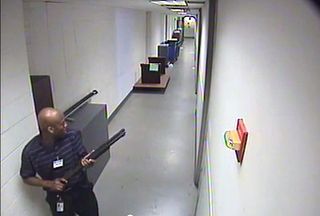
The Washington Navy Yard shooting occurred on September 16, 2013, when 34-year-old Aaron Alexis fatally shot 12 people and injured three others in a mass shooting at the headquarters of the Naval Sea Systems Command (NAVSEA) inside the Washington Navy Yard in southeast Washington, D.C. The attack took place in the Navy Yard's Building 197; it began around 8:16 a.m. EDT and ended when police killed Alexis around 9:25 a.m. It is the deadliest mass shooting in Washington, D.C. history, as well as the second deadliest mass murder on a U.S. military base, behind the 2009 Fort Hood shooting.
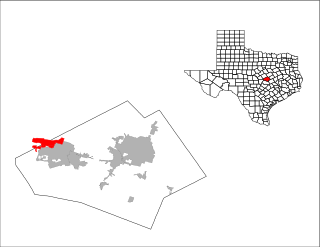
On Wednesday, April 2, 2014, a shooting spree was perpetrated at several locations on the Fort Hood military base near Killeen, Texas. Four people, including the gunman, were killed while 14 additional people were injured; 12 by gunshot wounds. The shooter, 34-year-old Army Specialist Ivan Lopez, died of a self-inflicted gunshot wound.
On February 26, 2015, a gunman shot and killed seven people in several locations across the town of Tyrone, an unincorporated community approximately 95 miles east of Springfield, Missouri, United States. The gunman, identified as 36-year-old Joseph Jesse Aldridge, was found dead of a self-inflicted gunshot wound the next day. It was the worst mass murder in the history of Texas County, which previously had experienced an average of one homicide per year. It is also the deadliest mass shooting in Missouri.

The Umpqua Community College shooting occurred on October 1, 2015, at the UCC campus near Roseburg, Oregon, United States. Chris Harper-Mercer, a 26-year-old student who was enrolled at the school, fatally shot an assistant professor and eight students in a classroom, and injured eight others. Roseburg police detectives responded to the incident and engaged Harper-Mercer in a brief shootout. After being wounded, he committed suicide by shooting himself in the head. The mass shooting is the deadliest in Oregon's modern history.
On September 10, 2017, a mass shooting occurred at a home in Plano, Texas, United States. The gunman, 32-year-old Spencer Hight, killed eight people and injured a ninth in the home before being killed by police.

On October 1, 2017, a mass shooting occurred when 64-year-old Stephen Paddock opened fire on the crowd attending the Route 91 Harvest music festival on the Las Vegas Strip in Nevada from his 32nd-floor suites in the Mandalay Bay hotel. He fired more than 1,000 rounds, killing 60 people and wounding at least 413. The ensuing panic brought the total number of injured to approximately 867. About an hour later, he was found dead in his room from a self-inflicted gunshot wound. The motive for the shooting is officially undetermined.

On November 5, 2017, at the First Baptist Church in Sutherland Springs, Texas, a local man, Devin Kelley, shot and killed 26 people and wounded 22 others. Kelley was shot and wounded by another local resident, then killed himself after a car chase. It is the deadliest mass shooting in Texas history and the deadliest at an American place of worship, surpassing the Charleston church shooting of 2015.
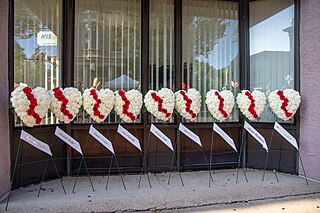
On August 4, 2019, 24-year-old Connor Betts shot and killed nine people, including his brother, and wounded 17 others near the entrance of the Ned Peppers Bar in the Oregon District of Dayton, Ohio. Betts was fatally shot by responding police officers 32 seconds after the first shots were fired. A total of 27 people were taken to area hospitals. It is the deadliest mass shooting to occur in Ohio since the 1975 Easter Sunday Massacre.

On August 31, 2019, a spree shooting occurred in the West Texas cities of Midland and Odessa, involving a gunman shooting multiple people from a vehicle. Eight people were killed, including the perpetrator, and twenty-five people were injured, including three police officers. It was the third major mass shooting to take place in the United States in August 2019, following the El Paso Walmart shooting and the Dayton shooting.

On April 18 and 19, 2020, 51-year-old Gabriel Wortman committed multiple shootings and set fires at 16 locations in the Canadian province of Nova Scotia, killing 22 people and injuring three others before he was shot and killed by the Royal Canadian Mounted Police (RCMP) in Enfield.

The Uvalde school shooting was a mass shooting that occurred on May 24, 2022, at Robb Elementary School in Uvalde, Texas, United States, when 18-year-old Salvador Ramos, a former student at the school, fatally shot 19 students and two teachers, while 17 others were injured but survived. After shooting and severely wounding his grandmother at their home earlier that day, Ramos drove to and entered the school, remaining in an adjoining classroom for more than an hour before members of the United States Border Patrol Tactical Unit fatally shot him after they bypassed numerous local and state officers who had been in the school's hallways for over an hour.
On November 22, 2022, Andre Marcus Bing killed six co-workers and injured four others before killing himself, in retaliation for perceived workplace harassment at the Walmart Supercenter where he worked as a night-supervisor in Chesapeake, Virginia, United States. Bing's suicide note cited concern he was being "led by Satan" and asking forgiveness - while also mentioning cancer treatments and loneliness.
On May 6, 2023, a mass shooting occurred at Allen Premium Outlets, an outlet center in Allen, Texas, United States. Nine people, including the perpetrator, were killed during the shooting, the youngest of whom was a three-year-old boy, and seven others were injured. The perpetrator was fatally shot by a police officer already in the area on an unrelated call.
